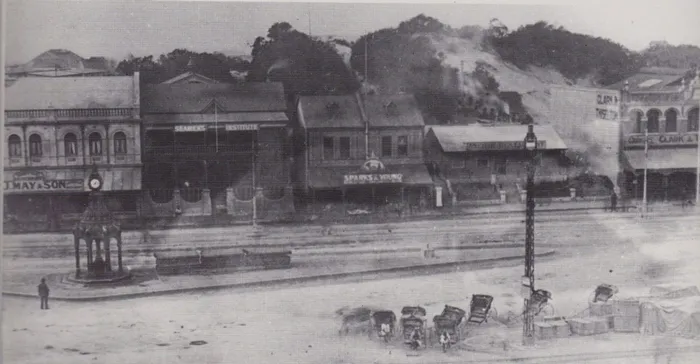Monument to our maritime history

The Vasco da Gama Clock in Point Road, c1905. Note the massive sand dunes in the background.
The old pictures today feature the Vasco da Gama Clock, which has had a long and chequered history and has been moved around the city on a number of occasions.
The clock was a gift from the people of Portugal to the city of Durban and was erected in Point Road in 1897 to mark the 400th anniversary of the Portuguese explorer’s voyage to India. During the voyage he discovered a large bay on the south-eastern coast of Africa on Christmas Eve, 1497, which he named “Natal”, the Portuguese word for Christmas. The area is today the province of KwaZulu-Natal and the city of Durban.
The Vasco da Gama memorial clock was manufactured by Macfarlane’s Saracen Foundry in Glasgow, Scotland, in cast iron to a design selected from their catalogue. Under the cupola, there was a statue of Samson on a pedestal. It is one of only three surviving examples in the world.
The clock was moved in 1997 for the 500-year ceremony to a spot on Durban’s Embankment (today Margaret Mncadi Road). It still had the statue of Samson intact.

By 2016, despite being a popular landmark and tourist attraction, the structure had fallen into disrepair. The statue and pedestal had been sold for scrap metal and the clock vandalised.
Recognising the significance of the historic structure, the Royal Natal Yacht Club initiated consultations with the eThekwini Municipality and Amafa for the restoration and temporary relocation of the structure. The Royal Natal Yacht Club has a long-standing maritime history as the oldest sports club in Africa and the oldest yacht club in the southern hemisphere.

After two years of consultations, permission was granted for the club to begin the preservation project. Once restored to its former glory, the clock will be temporarily located on the club’s Ndongeni lawns to be enjoyed by all citizens of eThekwini as well as tourists and visitors.
“It will serve as a reminder of the importance of our maritime industry and status as the trading gateway to Africa. The clock is once again set to become a popular feature of Durban within the redeveloped bayside waterfront and will no doubt become a favourite setting for wedding photographs, adding a new backdrop to this already popular venue,” the club said in a statement.

In Facts About Durban, Allan Jackson describes the vandalised clock. “The Samson figurine and the brass plaques were removed for scrap metal. It was decided that the clock would be temporarily moved to the Royal Natal Yacht Club as a sponsored/supported initiative between the Municipality’s Museums Department and RYNC under the leadership of Willy van der Vere.
“The clock has been dismantled and sandblasted, missing pieces are be sand-casted of aluminium. The octagonal plinth has been recast at RYNC in readiness for the structure to be painted and reassembled. The intention is to relocate the clock in a controlled environment for ‘safe keeping’ until such time as the Point is developed and the clock be relocated to its final resting place,” he writes.
Jackson noted that “there’s no telling why Samson was included in the Da Gama Clock in the first place, but it’s good that he’ll be replaced. It’s a pity that action wasn’t taken before the clock was vandalised but at least it didn’t suffer the same fate as a similar structure in Ireland which was almost totally destroyed by an IRA bomb and had to be recreated”.

Jackson found similar structures in places around the world. The Irish drinking fountain at Dun Laoghaire was more or less identical to our Da Gama Clock. It was bombed in the early 1980s and today is almost a complete replica, incorporating some original pieces.
There’s also the Haddington Fountain in Scotland which shares the same column and the same Samson on top. Merthyr Tydfil Drinking Fountain in Wales shares not only the same Samson, but also what seems like the same dome, gargoyles and face plate arches.
The Burgersdorp Drinking Fountain in the Free State is similar to our Da Gama Clock.


Most of the early photos of the clock we’re using today are from local historian Arthur Gammage including the unveiling of the clock in Point Road. In early Durban, Point Road was still called Scott Street but this fell away.
Our main old picture is also from Gammage and shows Point Road with the Da Gama Clock installed. Note the rickshaws waiting for business and the sand dunes behind the buildings that are higher than the buildings. The third is from a postcard of the time.


Gammage believes the clock was later dismantled from its position near the Point station and Southampton Road and was moved further down Point Road towards the harbour entrance, probably in the 1930s.
Our photographer Shelley Kjonstad’s pictures today show a very different Point, one with no sand dunes and that is slowly rejuvenating itself after many years of decline. She also photographed the Da Gama Clock on the lawns of the Royal Natal Yacht Club, awaiting final completion.
The Independent on Saturday

Related Topics: